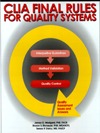CLIA Final Rule
Part IX: Appropriate QC Procedures
CLIA Final Rule:
Appropriate QC Procedures
If we realize that "equivalent" qc procedures are not equal... If we want to assure quality rather than comply with regulations... If we want to do the right QC, not the least QC... What is the appropriate QC to do? And how do we determine it? (preview)
- What QC is right for your methods?
- How do you characterize the performance of your method?
- Examples for practice
- What size errors are medically important?
- What size errors can be detected by a QC procedure?
- What QC is appropriate for methods with different Sigma metrics?
- How can you document the error detection of your QC procedures?
- Answers to examples for practice...and the appropriate QC procedures
- References
December 2003
In principle, the CLIA regulations require that laboratories perform the amount of QC that is appropriate for the methods in use in the laboratory. That’s the real meaning of section 493.1256 [1] and the following rules:
- QC should monitor the accuracy and precision of the complete analytic process;
- The laboratory should establish the number, type, and frequency of testing control materials;
- QC should detect immediate errors that occur due to test system failure, adverse environmental conditions, and operator performance;
In practice, CLIA also provides an easy way out, which is to run two levels of control every twenty four hours. You can make a choice between being in compliance with the regulations or being in control of quality! If you choose to be in compliance, you don’t need to read any further. Just run two levels of control every 24 hours. If you choose to control quality, that means doing the right QC for the methods in your laboratory so you can detect immediate errors.
What QC is right for your methods?
The problem is to figure out the right QC based on the accuracy and precision of the method, the number of control materials to be tested, and the size of the errors that are medically important and need to be detected immediately.
This issue comes up again and again at meetings, workshops, and seminars. People often hope for a simple answer, a single rule or set of rules that is right for all tests and all methods. Unfortunately, there isn't any single QC procedure that is right for all methods, not even multirule QC using "Westgard Rules"! However, there is a right QC procedure for each of your methods. That QC procedure can be identified by following a QC selection process that considers the quality required for the test, the precision and accuracy observed for the method, and rejection characteristics of the particular control rules and number of control measurements used by the QC procedure. The answer is not a rule or set of rules, but a process that leads to the right rule or rules for an individual test and method.
In this discussion, we're going to simplify this selection process and break it down into several steps:
- How do you characterize the performance of your method?
- What size errors are medically important?
- What size errors can be detected by a QC procedure?
- What QC is right for methods with different sigma metrics?
- How can you document the appropriateness of your QC procedures?
 Want to read the rest of this article?
Want to read the rest of this article?
We invite you to purchase the CLIA Final Rules manual, available through the online store. You can download the Table of Contents and a preview chapter for free.
